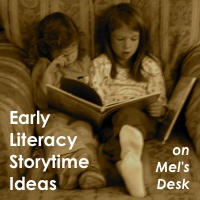I apologize for the long stretch since the last post in this series, but I am finally back with another way to add a literacy message to your storytime! Thanks for your patience!
My library has decided to focus our storytime literacy messages each month on a different one of the Every Child Ready to Read five practices that help children get ready to read. These practices are reading, writing, singing, talking, and playing. I’m used to doing a lot of reading, singing, talking, and playing in my storytimes–I know you are too–so it’s easy to find ways to model those practices to parents and caregivers.
But I have to admit that thinking of storytime in terms of writing skills is pretty new to me! So I read a bit about fine motor skills and pre-writing developmental milestones, and this month I’ll be sharing some of the ways I’ve brainstormed to highlight the “writing” practice in storytime–without handing out paper and crayons to the kids.
I look forward to hearing your thoughts and ideas about preschool writing skills too!
Today I’m just going to expand on an idea in my last Flannel Friday post. I shared a method of making smallish finger puppets so that every child in your storytime could have their own for this activity.
Hand out one puppet to each child (if you don’t have finger puppets or don’t care to use them, this will also work by having the children make “bunny ears” with their fingers, extending just the pointer and middle fingers of their hand). Wear a finger puppet on (or make bunny ears with) your hand too. Tell the children that their animal (or bunny) is going to go on an adventure! Lead the children through a short narrated sequence of events, having them copy with their puppets the motions you make with yours.
Here’s a couple of stories to get you started:
- Your puppets are going to go play hide and seek with a friend. Your puppet is the seeker! They look up on top of a hill (move the puppets straight up in the air), down in a tunnel (move the puppet straight down), across a bridge (move puppets left to right), and all around town (move the puppets in a large circle in front of your bodies). You can “find” the friend in a silly place, like on top of your head, or in your ear!
- A bunny is lost in the forest, and looks up in a tree, down in a hole, across a log, and around a lake, before finding his way home (a hole made out of the fingers of your other hand).
- A puppet goes to play on the playground: climbs up the slide and slides down, swings across the monkey bars, and rides on a merry-go-round.
- A bunny goes for a ride on a rollercoaster!
As you tell these stories, make sure to use the directional language words like up, down, across, and around.
When you’re done with your little puppet adventure, you can tell the grown-ups, “When you use words like up, down, across, and around when you play with your child, you’re helping them learn what these direction words mean. Your children will hear their teachers use these words when they are learning how to move their pencils to write their letters! If they already know what these words mean, they can concentrate on making the marks on the page.”
If you’d like to add more about why you’re talking about writing in storytime, you can say, “We know that children develop their reading skills and their writing skills at the same time. What they learn about reading helps them be better writers, and what they learn about writing helps them be better readers.”



.jpg)

6 Responses to Early Literacy Storytime: Directional Words